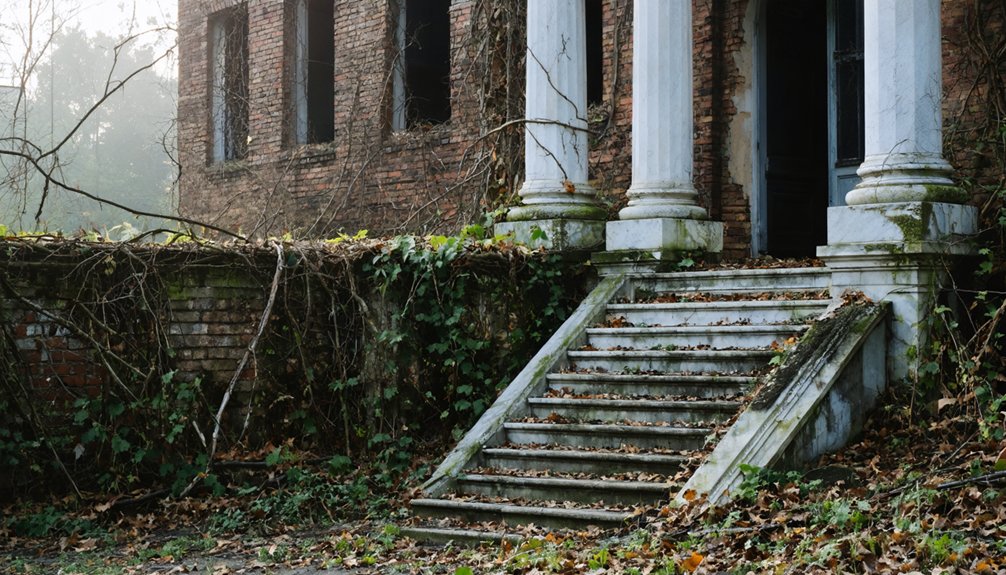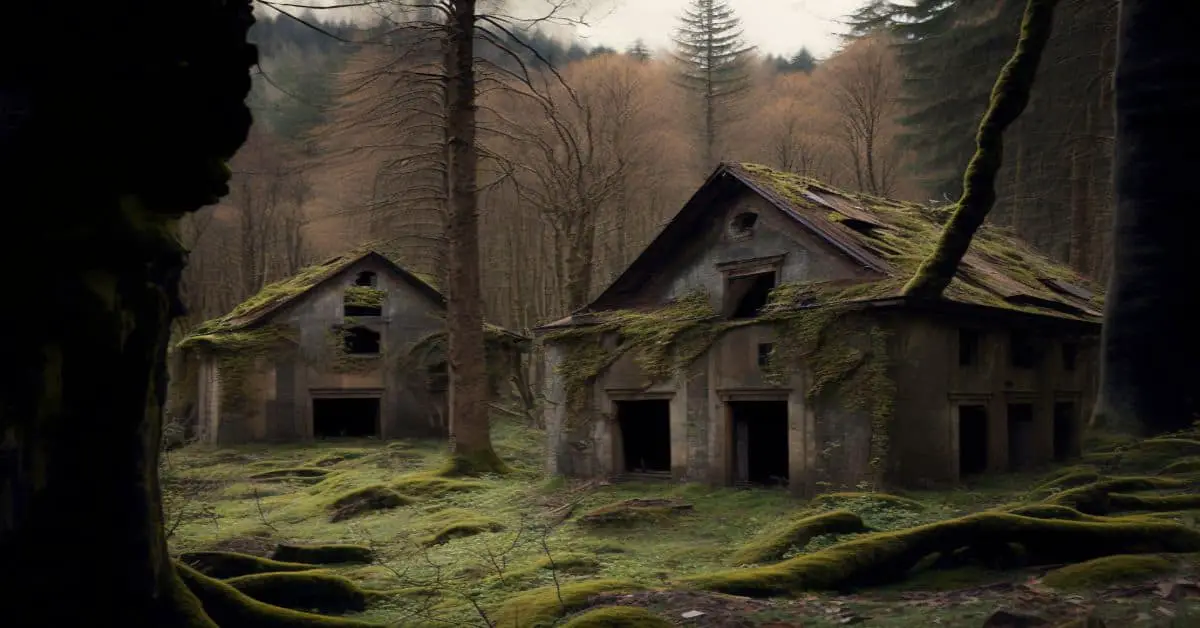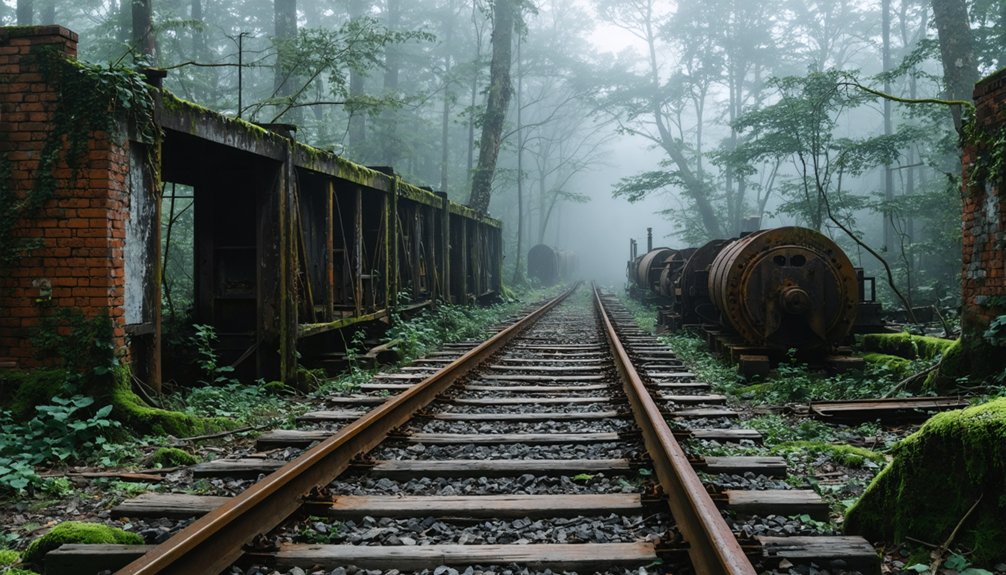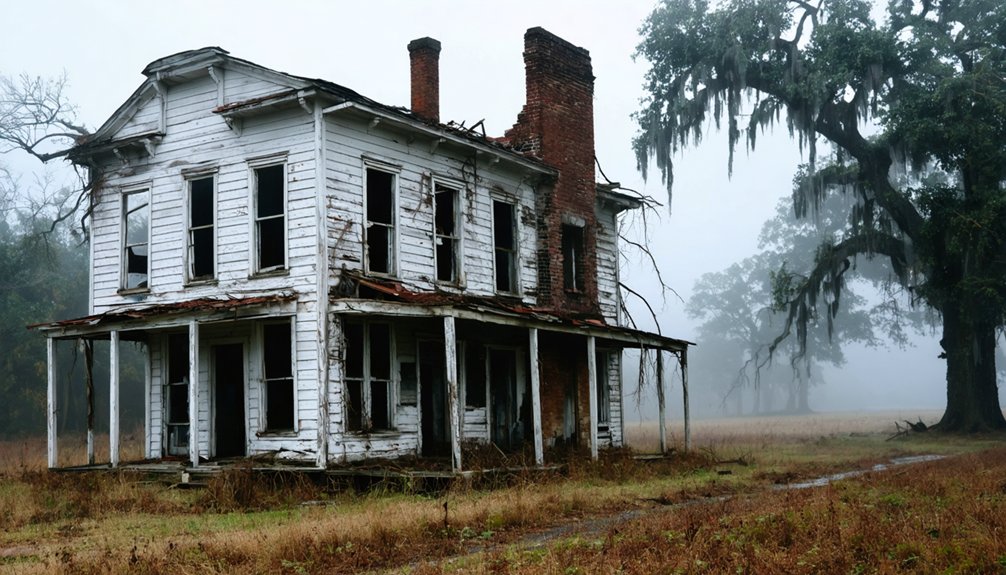You’ll find the haunting Lost Health Resort in Tskaltubo, Georgia, where grand Stalinist sanatoriums once hosted 125,000 annual visitors seeking healing in radon-carbonate springs. After the Soviet Union’s collapse in 1991, this prestigious wellness empire fell into decay, with its 22 major sanatoriums now standing abandoned. Today, urban explorers photograph decaying hardwood floors and medical artifacts, while over 10,000 refugees have transformed these former luxury spas into makeshift homes. The site’s rich history holds countless untold stories within its crumbling walls.
Key Takeaways
- Tskaltubo, Georgia’s abandoned Soviet-era health resort complex features 22 sanatoriums known for radon-carbonate springs and grand Stalinist architecture.
- Following the Soviet Union’s collapse in 1991, this once-prestigious wellness destination became a ghost town of decaying buildings and empty facilities.
- Over 10,000 refugees from the 1992 conflict made homes in the abandoned sanatoriums, creating makeshift living spaces within former luxury spas.
- Urban explorers can discover well-preserved ruins, including abandoned medical artifacts, grand pianos, and hardwood floors throughout the complex.
- Located between Dahlonega and Turner’s Corner, the site attracts adventure tourists seeking to document Georgia’s forgotten Soviet-era spaces.
Soviet Glory Days: Rise of a Wellness Empire
While many Soviet health resorts dotted the USSR’s vast landscape, Tskaltubo emerged as one of the nation’s most prestigious wellness destinations during its golden age from the 1950s to the 1980s.
You’d find 22 major sanatoriums at their peak, transforming this Georgian town into a wellness empire that served both the masses and elite alike. Daily trains from Moscow brought hundreds of thousands to experience the town’s radon-carbonate springs, marketed as cure-alls for various ailments.
Soviet prestige radiated through grand Stalinist architecture, with facilities like the 300-bed Sanatorium Iveria showcasing high ceilings, chandeliers, and sprawling ballrooms. The state guaranteed workers their “right to rest,” making Tskaltubo one of the top five resorts in the entire USSR, where health treatments merged with ideological messaging and collective leisure. Modern facilities offered visitors therapeutic experiences including mineral massages and mud baths. The project demonstrated remarkable ambition, taking ten years to complete from its groundbreaking in 1952 to its grand opening in 1962.
The Fall: When the Iron Curtain Crumbled
When the Soviet Union collapsed in 1991, Tskaltubo’s thriving health resort empire crumbled almost overnight. The Iron Curtain’s fall brought devastating economic impact to this once-prestigious wellness destination, transforming majestic sanatoriums into haunting shells of their former glory.
A testament to fallen empires, Tskaltubo’s grand spas stand silent, their healing waters flowing through empty halls of Soviet splendor.
You’ll find these stark changes reflected in:
- Abandoned infrastructure now overtaken by nature and urban explorers
- Complete halt of Moscow-bound trains that once brought 125,000 annual visitors
- Shift from structured medical tourism to sporadic nostalgic tourism
- Loss of state-funded health programs that sustained the resort’s operations
- Transformation of grand Soviet architecture into decaying monuments
The cultural shift was unmistakable as political changes dismantled the social fabric that kept Tskaltubo alive. The resort’s buildings now serve as makeshift homes for refugees from Abkhazia who sought shelter during the 1992 war. The once-bustling resort that attracted 100,000 annual tourists in its prime now only sees around 700 visitors per year.
Without Communist Party elites and workers filling its halls, the resort town’s health decline mirrored the broader collapse of Soviet-era institutions.
Echoes of War: Refugee Stories Within Ancient Walls
As you walk through Tskaltubo’s crumbling sanatoria today, you’ll encounter the living history of over 10,000 refugees who transformed Soviet-era luxury spas into makeshift homes following the 1992 Abkhazia conflict.
Within these weathered walls, displaced families have carved out spaces adorned with Orthodox icons, family photographs, and murals of their lost villages, creating a poignant archive of Georgia’s refugee crisis. The rising tourism industry has led some residents to find creative income sources by offering guided tours to visitors. During recent elections, several of these abandoned buildings served as polling stations for the local community.
Despite harsh conditions – including sporadic electricity and limited running water – these resilient communities have maintained their cultural identity while adapting Soviet-era treatment rooms and corridors into communal living spaces that echo with three decades of displacement stories.
Lives Frozen in Time
Inside the abandoned Soviet-era wellness resort of Tskaltubo, Georgia, a poignant chapter of human displacement unfolded after the 1992 Abkhazia conflict forced over 200,000 Georgians from their homes.
Within these walls, you’ll find evidence of community resilience and memory preservation frozen in time:
- Wooden medicine boxes and a grand piano remain untouched, silent witnesses to sudden evacuations
- Former guest cabins transformed into decades-long refugee shelters for 10,000 displaced people
- Birth and death cycles occurred within these walls, creating new layers of human history
- Social distancing stickers from 2020 elections mark the buildings’ continued community use
- Youth gatherings and scattered beer bottles reveal ongoing cultural imprints despite abandonment
The resort stands as both a memorial to lost prosperity and a reflection of human adaptability in crisis.
Like the forgotten Porter Springs Resort that once charged $1.50 per day, these ruins tell stories of a more prosperous era. Similar to the Temple of Health’s legacy, guests once flocked to the property seeking healing from its mineral springs.
Walls Tell Their Stories
Through the weathered walls of Tskaltubo’s abandoned sanatoriums, you’ll find layered histories etched in stone, plaster, and paint.
These silent witnesses bear the marks of dramatic transformation – from luxury health resort to refugee shelter after the 1992 Abkhazia conflict, when 10,000 displaced Georgians sought safety within these walls.
You’ll discover wall narratives spanning decades: original hardwood floors and decorative masonry from its resort days, alongside makeshift partitions and personal belongings left by refugees who made these spaces their homes.
Much like the Oak Mountain Springs Resort of the 1850s, these grounds once echoed with the sounds of families gathering for dances and social events.
Bullet holes and hasty repairs tell stories of conflict, while graffiti, murals, and informal signage reveal ongoing cultural interactions.
Every surface holds evidence of survival, displacement, and resilience – from birth to death, from peace to war, these walls continue to speak.
Finding Peace Among Ruins
While Tskaltubo’s abandoned sanatoriums stand as haunting reminders of Georgia’s Soviet past, they’ve become powerful symbols of human resilience and adaptation.
Within these resort memories, you’ll find remarkable stories of community resilience, where over 10,000 refugees transformed deteriorating buildings into vibrant homes after the 1992 Abkhazia conflict.
- Former grand pianos and medicine cabinets whisper tales of the buildings’ elegant past
- Families have lived, died, and welcomed new life within these weathered walls
- Refugees turned cold hallways into warm gathering spaces
- The structures now serve as polling stations and social hubs
- Urban explorers and tourists discover beauty in the ruins’ evolving story
Today, as many refugees move to modern housing, these buildings continue their transformation, bridging past grandeur with present-day purpose.
Urban Explorers Paradise: A Modern Tourist Draw
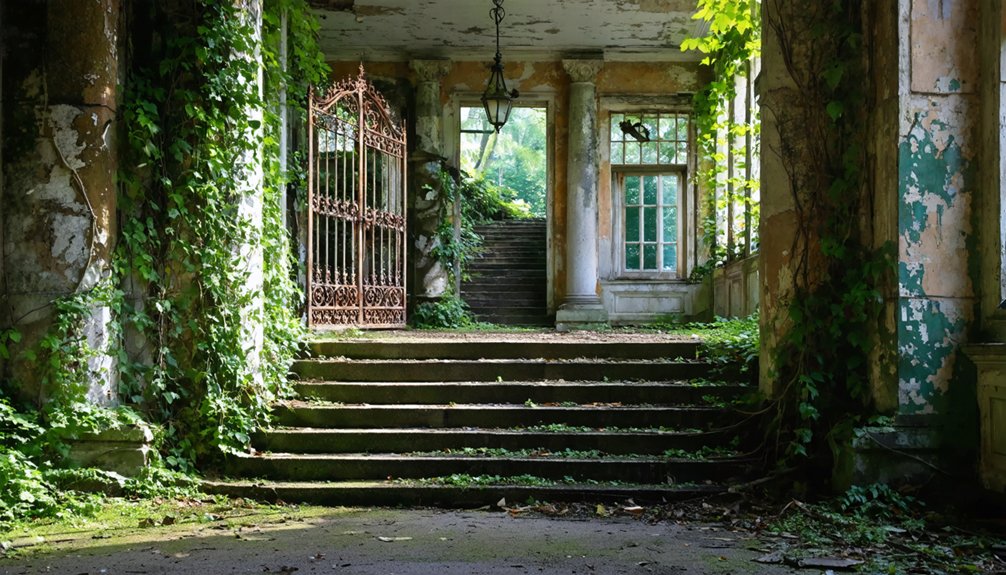
You’ll discover the Lost Health Resort‘s haunting allure through its decaying hardwood floors and abandoned medical artifacts, which draw urban explorers from across Georgia.
The site’s well-preserved ruins, including the recreation hall with its grand piano and scattered medicine boxes, offer photographers unique opportunities to capture the intersection of nature and architectural decline.
The resort’s convenient location between Dahlonega and Turner’s Corner has transformed this former health destination into a prime spot for adventure tourists seeking to document Georgia’s forgotten spaces.
Capturing Decay’s Hidden Beauty
As nature slowly reclaims the abandoned Soviet-era health resorts of Tskaltubo, Georgia, a haunting beauty emerges from their decay.
You’ll find an otherworldly tableau where decay aesthetics blend with nature’s persistent advance, creating scenes that photographers and explorers can’t resist.
- Spring-fed pools now host frogs and turtles in murky waters where patients once sought healing
- Soviet modernist architecture stands frozen in time, with untouched beds and positioned lamps
- Graffiti and modern murals layer atop crumbling walls, telling stories of ongoing human interaction
- Weather-worn structures frame dramatic shots as sunlight filters through broken windows
- Radioactive spa remnants add an element of dangerous mystique to your exploration
The nature reclamation creates an eerie yet enchanting atmosphere that transforms these ruins into living galleries of time’s unstoppable march.
Stalin’s private bath remains largely preserved, though it was reportedly only used once by the Soviet leader during his visits.
Adventure Tourism’s Rising Star
Beyond its photographic allure, Tskaltubo has emerged as a magnet for modern adventure tourists seeking immersive urban exploration experiences.
You’ll find yourself at the forefront of a booming trend, as global urban tourism soars toward an $11.39 trillion valuation by 2032. The abandoned health resort perfectly aligns with Millennials’ and Gen Z’s hunger for unique, historically rich destinations that offer more than standard sightseeing.
As adventure tourism evolves, you’re part of a new wave of travelers demanding authentic experiences in unconventional settings.
Tskaltubo’s vast complex of deteriorating Soviet-era structures provides the ideal backdrop for urban exploration, matching the growing market for niche activities and personalized adventures.
With smart technology integration and real-time navigation tools, you’ll discover this ghost town’s secrets while contributing to the sustainable preservation of its haunting heritage.
Architectural Remnants: Beauty in Decay
Decay intertwines with grandeur throughout Tskaltubo’s abandoned Soviet-era structures, where Stalinist architecture meets nature’s slow reclamation.
Time and nature slowly consume the Soviet grandeur of Tskaltubo, where abandoned halls echo stories of faded glory.
You’ll discover an architectural beauty that tells stories of a bygone era, where marble corridors and ornate chandeliers stand in stark contrast to crumbling staircases and overgrown vegetation.
- Hotel Medea’s neoclassical columns frame wedding photos among its elegant ruins
- Bathhouse 6’s ornamental marble corridors whisper tales of Soviet-styled luxury
- AMRA’s blend of Stalinist and neoclassical elements creates a unique architectural identity
- Trees now grow through once-opulent ballrooms, creating haunting natural galleries
- Deteriorating tiles and broken facilities in Bathhouse 5 reveal time’s unrelenting march
These remnants of historical significance aren’t just decaying structures – they’re living museums where you can touch, explore, and photograph the physical manifestations of Soviet grandeur’s fall.
Between Past and Future: A Town in Transition
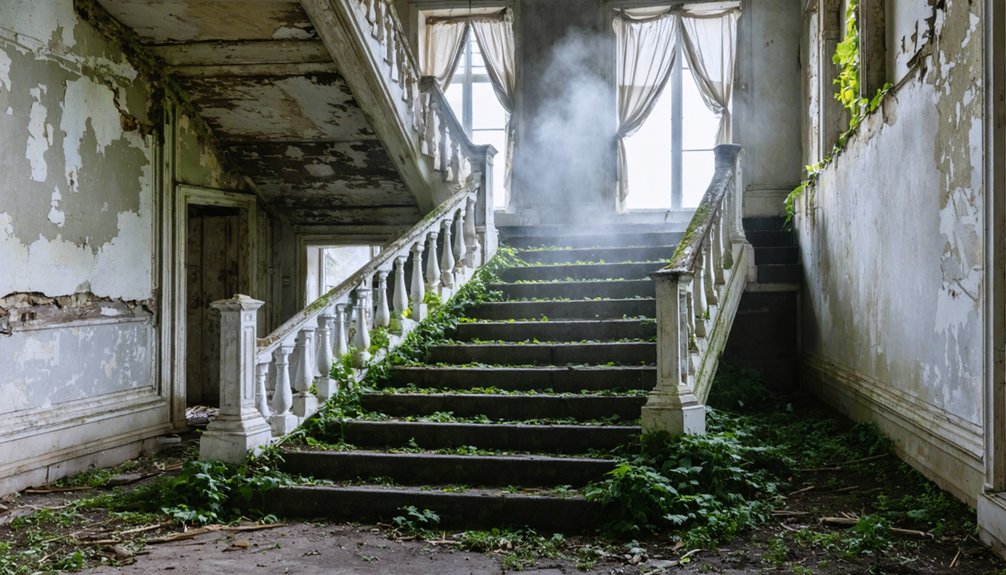
While Soviet grandeur once defined Tskaltubo’s identity, today’s reality presents a complex shift between its storied past and uncertain future.
You’ll find a town caught between cultural resilience and ambitious redevelopment, where IDP families have carved out lives in crumbling sanatoriums for three decades.
The transformation is gaining momentum. You’re witnessing international investors and Georgian billionaires proposing new visions for the town’s revival.
By 2025, you’ll see former Soviet retreats metamorphosing into modern hotels, with names like Marriott replacing Cyrillic signage.
Yet historical preservation hangs in the balance as development plans threaten to erase architectural heritage.
The town stands at a crossroads where the echoes of 1,500 daily spa visitors meet the promise of contemporary wellness tourism, leaving you to wonder what traces of its past will survive.
Frequently Asked Questions
Are the Mineral Springs Still Active and Safe for Bathing Today?
Like ancient Roman baths fallen silent, you can’t safely bathe in these mineral springs today – there’s no recent scientific confirmation of their activity or safety monitoring at this abandoned location.
What Is the Current Population of Permanent Residents in Tskaltubo?
You’ll find approximately 7,378 permanent residents in Tskaltubo today, reflecting the town’s dramatic economic decline from its Soviet-era spa glory, when it once welcomed 125,000 annual visitors to its mineral springs.
How Can Visitors Legally Access and Explore the Abandoned Buildings?
You can freely walk between most unsecured buildings since there’s no official entry system. While urban exploration isn’t explicitly prohibited, you’ll need to stay alert for safety regulations and respect occupied spaces.
What Happened to the Original Medical Equipment and Furniture?
You’ll find most medical relics were scavenged after Soviet collapse, with valuable equipment stolen or sold. Some historical significance remains in Bathhouse 6, but original furniture’s exact fate remains undocumented.
Is There Local Opposition to the Growing Urban Exploration Tourism?
While urban preservation conflicts exist, you’ll find mixed local reactions: some welcome tourism’s economic benefits, while others voice community concerns about disruption to daily life and historical authenticity in Tskaltubo.
References
- https://matadornetwork.com/read/tskaltubo-abandoned/
- https://www.youtube.com/watch?v=-2Er0qKGdCc
- https://www.gainesvilletimes.com/columnists/johnny-vardemans-column/ghost-town-health-resort-in-lumpkin-county-drew-crowds/
- https://www.randomconnections.com/the-temple-of-health-trembly-bald/
- https://www.urbex.nl/sanatorium-iveria-tskaltubo/
- https://www.youtube.com/watch?v=QHBTyxHuK3Y
- https://www.balcanicaucaso.org/eng/Areas/Georgia/The-Soviets-Right-to-Rest-That-is-no-Longer-178430
- https://www.telegraph.co.uk/travel/destinations/europe/georgia/tskaltubo-soviet-spa-town/
- https://www.comradegallery.com/journal/soviet-sanatoriums-tskaltubo-georgia
- https://magazine.tank.tv/issue-69/features/william-dunbar-vladimir-shioshvili-georgia/
